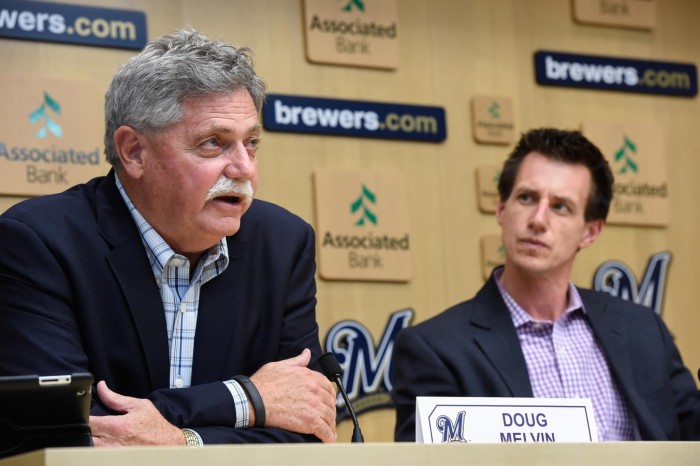The number one story here at Baseball Prospectus Milwaukee has been the reorganization of the front office in the wake of the Brewers’ dreadful 2015. On September 21st, general manager Doug Melvin transitioned to an advisory role within the organization and made way for a new GM, David Stearns, formerly the assistant general manager for the Houston Astros. Just 30 years old, the Harvard-educated Stearns represents a new direction for the Brewers compared to the traditional baseball-lifer in Melvin.
The day after Stearns took over, our own J.P. Breen posted his analysis of the move at our parent site. The Brewers’ future had been up in the air for months after the firing of Ron Roenicke, the installation of Craig Counsell as manager, and the subsequent search for a general manager. The Brewers were connected to all kinds of candidates, ranging from traditional candidates more in the Melvin mold to the extreme youth-and-numbers candidate they eventually selected in Stearns.
As Breen wrote, Stearns’s selection finally put a direction to the Brewers future. “Recent interviews and overall practices in Houston hint at what the New York native could bring to Milwaukee.” Breen wrote. “He has spoken strongly in the past about prioritizing scouting in Asia and the Pacific Rim, something that has not traditionally happened in Milwaukee. Using all data (technological and human) available to shape development and decision-making processes has also come up multiple times in interviews.”
In October, here at BP Milwaukee, Breen expanded on the possibilities the injection of youth into the front office in the form of Stearns and his new assistant GM Matt Arnold, a 36-year-old who had previously worked in the Tampa Bay Rays organization. While the anti-statistics tendencies of the Brewers under Melvin were greatly exaggerated, there’s no question Stearns and his new-age staff are going to have a different ideological approach to building a baseball team than Melvin’s crew did.
The real question, Breen asserts, is not whether the Brewers can bring their organization up to speed on their use of data and technology. Rather, it’s what new ideas Stearns, Arnold, and the rest of the organization can bring to the table. “The real difference maker in Milwaukee will be discovering the next competitive advantage that no one has exploited, the next market inefficiency, if you will,” Breen writes. “Simply using mountains data on framing, spin rates, defensive efficiency, and the like to drive coaching methods and roster decisions won’t be enough.”
Unfortunately, it’s too early to make any real judgments about Stearns or his strategies. The Brewers have been making a bunch of moves this offseason, picking up prospects for veterans like Adam Lind and accruing young, fringe players like Jonathan Villar and Ramon Flores who will have their chance to play their ways into bigger roles. Stearns has really yet to make a major move, though — a trade of a high profile player like Jonathan Lucroy or Ryan Braun or a major free-agent deal — and it’s those moves that tend to tell us more about a GM.
Much of our coverage has focused on Stearns, his new approach, and the future of the Brewers. We didn’t talk much about Melvin and his work in building the Brewers up from a perennial loser to a team that reached the playoffs twice in four seasons. Melvin had his problems — specifically, a farm system that was all but devoid of talent. Between 2010 and 2012, as I wrote in the 2014 Baseball Prospectus Annual, the Brewers farm system produced just 5.0 WAR, 3.2 of which came from late-bloomer Mike Fiers.
But Melvin built successful teams through a shrewd ability to identify undervalued Major League players who could fit into the Milwaukee clubhouse and help teams compete. Seemingly minor pickups like Gabe Kapler, Chris Narveson, Casey McGehee, Nyjer Morgan, Jerry Hairston Jr., and John Axford, all acquired for minimal expenses, contributed in huge ways to the 2008 and 2011 playoff teams. This was one of Melvin’s great talents, the ability to find the diamond in the rough, the missing piece, and to integrate it seamlessly into a roster.
David Stearns has a lot of work to do in assembling the core of the next Brewers contender. The farm system is starting to fill up again, but it will need to keep growing in order to supply the Brewers with the players they need to consistently contend again. We can be sure Stearns has a detailed plan and approach. But he’ll also need to display some of that magic touch Melvin showed in assembling those final pieces to a playoff team. Hopefully, with Melvin sticking around to advise the young general manager, some of Melvin’s magic will rub off on Stearns.

1 comment on “Top Brewers Storylines of 2015: Stearns In, Melvin Out”